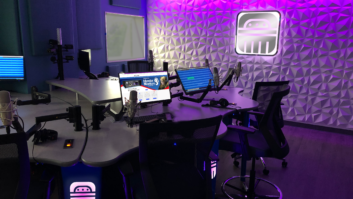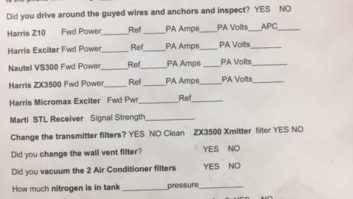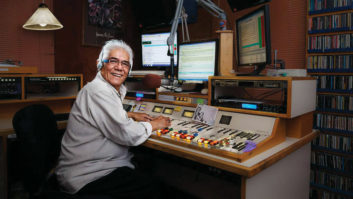
I can’t remember the last time I got my mitts on a new product that was so obviously the result of paying attention to the marketplace.
Radio equipment budgets are downsizing. Broadcasters of all flavors are forced to rely on mixers that, however excellent their sound qualities, are designed for use by musicians. Thus all those add-on boxes that clutter up studios from New York to New Mexico to my house.
Sooner or later, deep in the back rooms of some mixer manufacturer, a light bulb was bound to turn on. In Cornwall, England, it did. Allen & Heath, which has turned out high-quality mixers for recording and live sound for decades, has found itself a new market. Meet the XB-14 Radio Broadcast Mixer.
Although it would be inexcusably un-British, A&H could justifiably have stenciled “We heard you” all over the box.
Needed features
Look at all the outboard gear I was able to yank from my studio when I disconnected my name-brand made-for-musicians mixer and fired up the Allen & Heath XB-14:
- • Relay box for muting studio speakers and switching four microphones
- • Talkback box for communicating with voice booth talent
- • Separate talkback box for communicating with telephone guest (and I could only work with one of those at a time, which I’ll get to in a minute)
- • USB audio interface box for sound in and out of the computer
- • Auxiliary input selector box that brings in all the sources for which my mixer didn’t have enough stereo faders
- • Guest headphone control box
- • Guest talkback box
Every one of these metal and plastic helpmates was in perfect working condition and doing what I needed it to do. But with the XB-14? Ancient history. Or in that priceless British phrase: made redundant.
Of course, if you’re working with full-featured professional studio consoles, you may not need all those boxes. But what if you’re a small station? A newsroom? A station where an extra studio would come in handy if only the cost came in handy, too. How about LPFM? Voice talent with a personal studio? You could equip all of them with combinations of mixers and outboard gear but now you don’t have to. With the XB-14, it’s all in the box. One box.
Let’s take a look at features the XB-14 brings to the studio that normally exist only in full-fledged consoles priced north of five grand — some far north:
- • Fader-up mic muting/on-air light control? Check.
- • Pushbutton-select A/B inputs on all stereo channels? You bet.
- • Available fader start on all inputs of all stereo channels? Boom, baby!
- • Dedicated telephone channels with individual talkback? The XB-14 has two, with individual EQ and program/aux feed select. Some so-called full-featured consoles don’t even have one dedicated phone channel, never mind the gravy.
- • Separate guest headphone control with talkback? Yessir.
- • External monitor select? Oh, yeah.
- • 100 mm long-throw faders? Ten, count ’em.
- • Lots of inserts and auxiliary inputs and outputs? No fair, since many big boards have few if any.

When you sit down with the XB-14, you actually feel as though you’re working with a real radio console, not a musicians’ mixer with a herd of external boxes. The steel faceplate has a solid feel, and those long faders provide a downright luxurious range of mixing levels.
The XB-14 is customizable. Users don’t have to have the mics muted when their faders come up. DIP switches on the back let the user decide what’s on, what mutes and what doesn’t. Machine start on the stereo faders is handled through D-sub plug sockets on the rear. Same for on-air light control and any external VU meters you might want to install. Everything else is ready to go out of the box.
Let’s take a look at the XB-14, section by section.
The first four channels are for microphones or line-level inputs. Here users have a choice of XLR mic input, 1/4-inch line or 1/4-inch insert jacks. Each channel includes a trim pot that adjusts attenuation from –6 dB to +63 dB on the XLR jack or –10 dB to +26 dB for the line jack. Users can reduce pop noise and rumble on each of these pots by punching in a 100 Hz high-pass filter, which works for both XLR and line inputs.
Each of the first four channels features Allen & Heath’s musical four-band EQ — one high-frequency, two mid-range and one low-frequency equalizer. These channels also include an aux bus assign control that can send a signal to the auxiliary stereo bus.
The 100 mm faders are smooth and have a nice tactile feel. And yes, if users engage the proper activation button in the master control section, each will mute the control room speakers when it’s moved up. This action is dependable and silent.
Faders 5 and 6 control the XB-14’s handy Telco channels. These are identical channels that receive and send audio to two separate POTS and include: XLR jacks for signals coming from and going to the hybrid; a trim pot; switchable high-pass filter; and EQ pots for high- and low-frequency tweaking.
Telco channels
A terrific feature of each telco channel is its integrated talkback button, which allows hosts on any of the first four channels to speak directly to callers through their mics with the mic faders down.
Another useful feature is the CLF SCE — or Clean Feed Source — button. In the up position, the caller is fed straight mix-minus audio including all program elements. Push it down and users can feed whatever is on the aux channel, which can be any combination of the XB-14’s faders.
This setup is also great if the XB-14 is used as a main control console and the user wants to record phone conversations off the air. Using a combination of the CLF SCE button and mic channel prefader selectors users can record both sides of a conversation in the same way that they might use the audition channel of a larger console. This works great and is nice and clean.
There’s also a Mix B button, which routes the channel signal to a separate stereo bus for recording or feeding other equipment.
While I did not have the opportunity to utilize both telco channels, I used one in conjunction with my JK Audio Broadcast Host Digital Hybrid to record a number of interviews. They went off flawlessly and sounded clean and professional. I kept my XB-14 review unit longer than usual because I wanted to use it for these interviews. It gets habit-forming quickly.
By the way, each telco channel includes a 1/4-inch line-in jack, so if one or both are not needed for phone work another mono source can be plugged into them.
Next on the XB-14’s topography come three dual-input stereo channels. Each accepts one stereo input on 1/4-inch plugs and one on RCA connectors. A separate level control adjusts the trim for each input. Users select Stereo 1 or Stereo 2 with a pushbutton; indicator lights above and below the button show which input is selected. Each stereo channel includes a two-band EQ section. One of the two stereo inputs for channel nine is USB audio coming from a computer.
Channel 10 features one stereo input.
Product Capsule Allen & Heath XB-14 Radio Mixer
Thumbs Up
- • Full-featured radio replacement for ‘musician’ mixers
- • Fader-up mic muting and machine start (machine start requires D-sub on back of unit)
- • Two dedicated, full-featured telco channels with talkback
- • Pushbutton-select A/B inputs with tally lights on stereo channels
- • 100 mm long-throw faders
Thumbs Down
- • Machine start on stereo channels needs to be normaled (without need to wire-up a D-sub)
Price
$1,295 retail
For information, contact Allen & Heath/American Music & Sound in California at (800) 994-4984 or visit www.americanmusicandsound.com or www.allen-heath.com. All 10 channels include nice big illuminated ON buttons, PFL (prefader listen) buttons, which send the audio from that channel to the control room speakers and headphones but not to air, pan pots and peak and signal indicator lights.
Direct USB connections, which provide clean audio directly into and out of computers, used to be convenient extra features on mixers and consoles. More and more, however, they’re becoming necessities. Since so much broadcasting and recording audio now interfaces directly with computers, it’s good to be able to do so directly from the board — another external box eliminated. In my studio tests, the XB-14’s USB connection shook hands flawlessly with both a PC and Mac.
The XB-14’s comprehensive Master section includes the usual suspects found in a tabletop mixer with a few nice extras for broadcasting. An external monitor input is ideal for the air monitor (I feed mine with an old stereo component tuner) and users can switch this input to the speakers and headphones for true off-air monitoring.
In addition to the expected controls for control room and guest headphones, there’s a Talk To Guest button that enables talkback to guests. Other selections allow users to feed Aux, Mix B, USB audio or external monitor signals to the guest headphones.
Adequate 12-segment LED meters show levels. Naturally, the board provides 48 V phantom power to the four XLR connectors.
The power supply is internal, though close listening revealed no audio effect. This does cause the board to run a little warm, but not noticeably so.
According to the manual, components and construction is as on A&H’s larger boards, “utilizing individual vertically-mounted channel circuit boards with each rotary control fixed with a metal nut to the front panel.” The company says this approach resists damage and lengthens service life.
In operation, the XB-14 is smooth and reliable. Before long, I began to refer to it as a board instead of a mixer because, with its complement of radio-specific features in addition to the clean audio we’ve come to expect from high-end tabletop mixers, it really does feel like serious professional equipment that belongs in a radio station instead of a musician’s project studio.
I didn’t use the board in a harsh RF environment so I can’t comment on RF immunity.
You could run a busy radio studio with the Allen & Heath XB-14. With a street price at or below a grand, I won’t be surprised if a number of stations begin to do just that.
Doug McLeod is a longtime baseball play-by-play announcer, voice talent, sales management consultant and radio station general manager.







